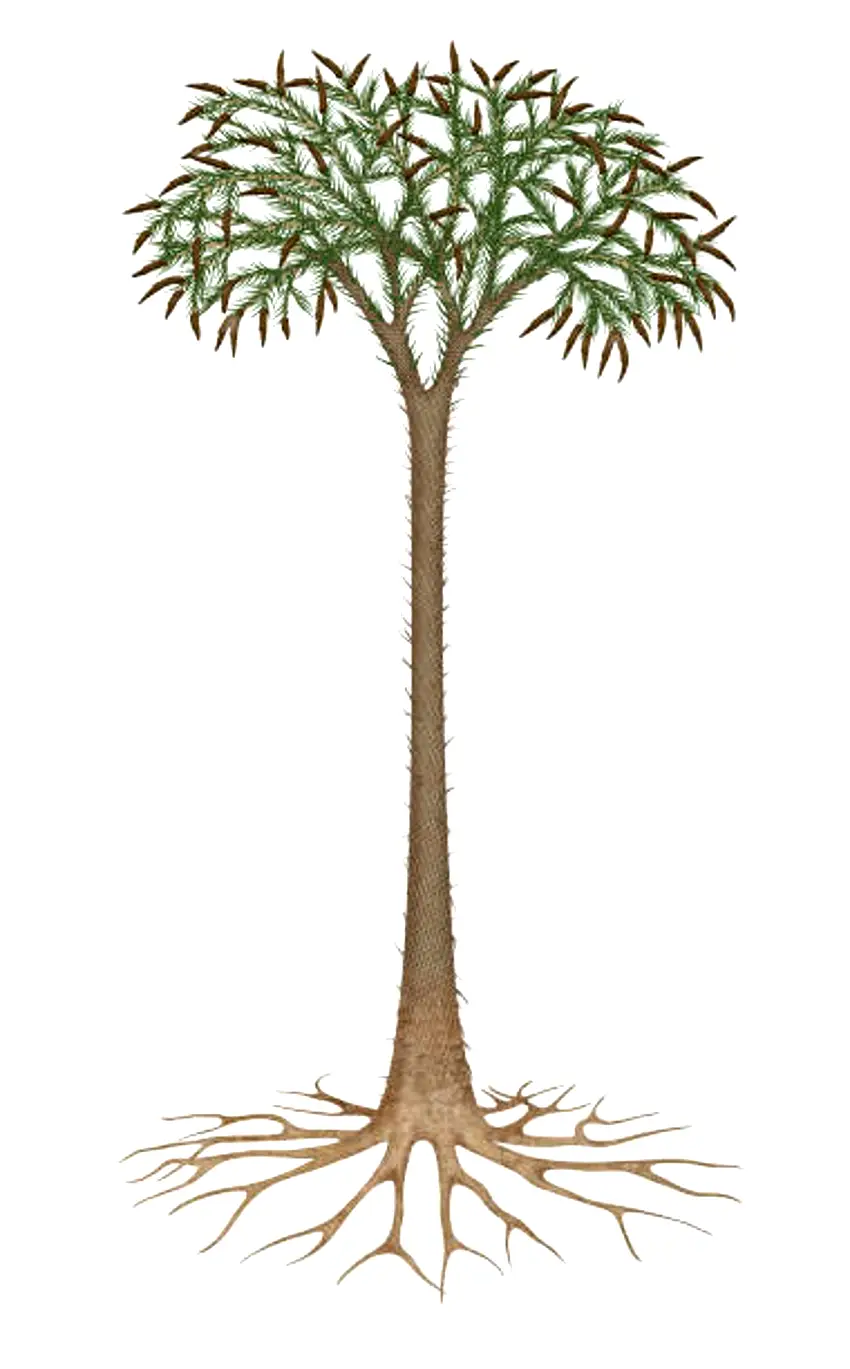Contents
CLASSIFICATION OF LEPIDODENDRON
Kingdom :- Plantae
Division :- Pteridophyta
Sub-division :- Lycopsida
Class :- Lycopodiopsida
Order :- Lepidodendrales
Family :- Lepidodendraceae
Genus :- Lepidodendron
STUDY OF THE EXTERNAL FEATURES OF THE PLANT OF LEPIDODENDRON
- Lepidodendron with over 100 species, is the largest known genus. It is found in the shales and sandstones of carboniferous coal bearing formations.
- The root system is included in the form genus Stigmaria, leaves in form genus Lepidophylloides and the strobili in the form genus Lepidostrobus.
- Lepidodendron was a tall tree reaching 40 meters. The trunk was straight that branched dichotomously only at the top. The branches were shorter.
- The branches were covered with spirally arranged leaves, placed in the form genus Lepidophylloides. These were simple, ligulate, acicular to linear. A single vein traversed the length of a leaf.
- Leaves were attached to the summit of pyramidal cushion-like leaf bases which were rhombic or diamond shaped. The leaf scars formed oblique or spiral rows on the stem. Actual leaf scar was above the middle line of rhombus. In the leaf scar, the bundle scar mark was flanked by two scars and at the lower level by two more large scars which represented parichnos scars (strands of loosely arranged parenchyma).
- Typical Lepisdodendron trunk was attached to a typical stigmarian root system. The base of the trunk was divided into four massive rhizophores which later again divided dichotomously.
- The strobili borne terminally were found attached to a branch identical to Lepidodendron and are placed under the form genus Lepidostrobus
ANATOMY OF STEM OF LEPIDODENDRON
- It shows a protostele or siphonostele with exarch and polyarch protoxylem.
- Metaxylem was present in the centre with many protoxylem points on periphery.
- A ring of cambium situated outside produced a narrow zone of secondary xylem. Both primary and secondary xylem were made of scalariform and spiral tracheids.
- A large cortex surrounded the vascular tissues. It showed four regions-
- Inner cortex: homogeoneous and made of parenchyma except for leaf traces.
- Secretory zonemade of intermingled large and small cells, many of which were filled with a dark coloured substance.
- Middle cortexthat consisted of delicate cells which were often destroyed.
- Outer cortexmade of alternate radial masses of thick and thin walled elements.
- Outermost was the periderm formed by phellogen. It consisted of many elements on its inner side forming endophelloderm than on the outer side that formed exophelloderm.
STUDY THE STROBILUS OF LEPIDODENDRON
- The strobili borne by Paleozoic lepidodendrids are placed in organ genus Lepidostrobus. All known species are heterosporous.
- Strobili occurred on terminal parts of certain smaller branches. The strobili were elliptical, 1 to 7.5 cm in diameter and 2.5 to 30 cm or more long.
- Each consisted of a central axis around which sporophylls were found in spirals or whorls (in some cases verticillate).
- The sporophyll was peltate with the upper terminal lobe overlapping the sporophyll above. The sporophylls were attached at right angles to the axis.
- Each sporophyll bore a single sessile elongate sporangium on its adaxial face. Just beyond the sporangium, the sporophyll had a small ligule.
- There was also a shorter downward prolongation of the lamina called heel, completely covered by the lamina of the sporophyll below.
- The sporangium was a large sac-like structure wider than the sporophyll. The wall was of a single layer of prismatic cells. Some radiating flaps of tissue called trabeculae extended upward from the base of the sporangium.
- The microsporangia and megasporangia are of the same size.
- Microsporangium enclosed several hundred microspores. Megasporangium enclosed 4, 8, or 16 megaspores.
- Megaspores showed gametophytic development while still within the megasporangium.
IDENTIFICATION OF LEPIDODENDRON
- DIVISION – Pteridophyta
- True roots generally present (except in Psilopsida),
- True vascular strand present.
- Sub-division:- Lycopsida
- Leaves microphyllous,
- Sporangia borne singly on adaxial face of the sporophyll or in its axil.
- Sporophylls borne in strobili
- Order– Lepidodendrales
- Plants tree-like.
- Secondary tissues formed by means of a cambium.
- Leaves microphyllous, ligulate.
- Strobili heterosporous
- Family– Lepidodendraceae
- Aerial portion freely branched,
- Strobili at the tips of branches.
- Trunk and branches with spirally arranged leaf scars
- Genus – Lepidodendron
- The vertical diagonal of the rhombus longer than the tranverse.
- Cones borne on short lateral branches.


Leave a Reply